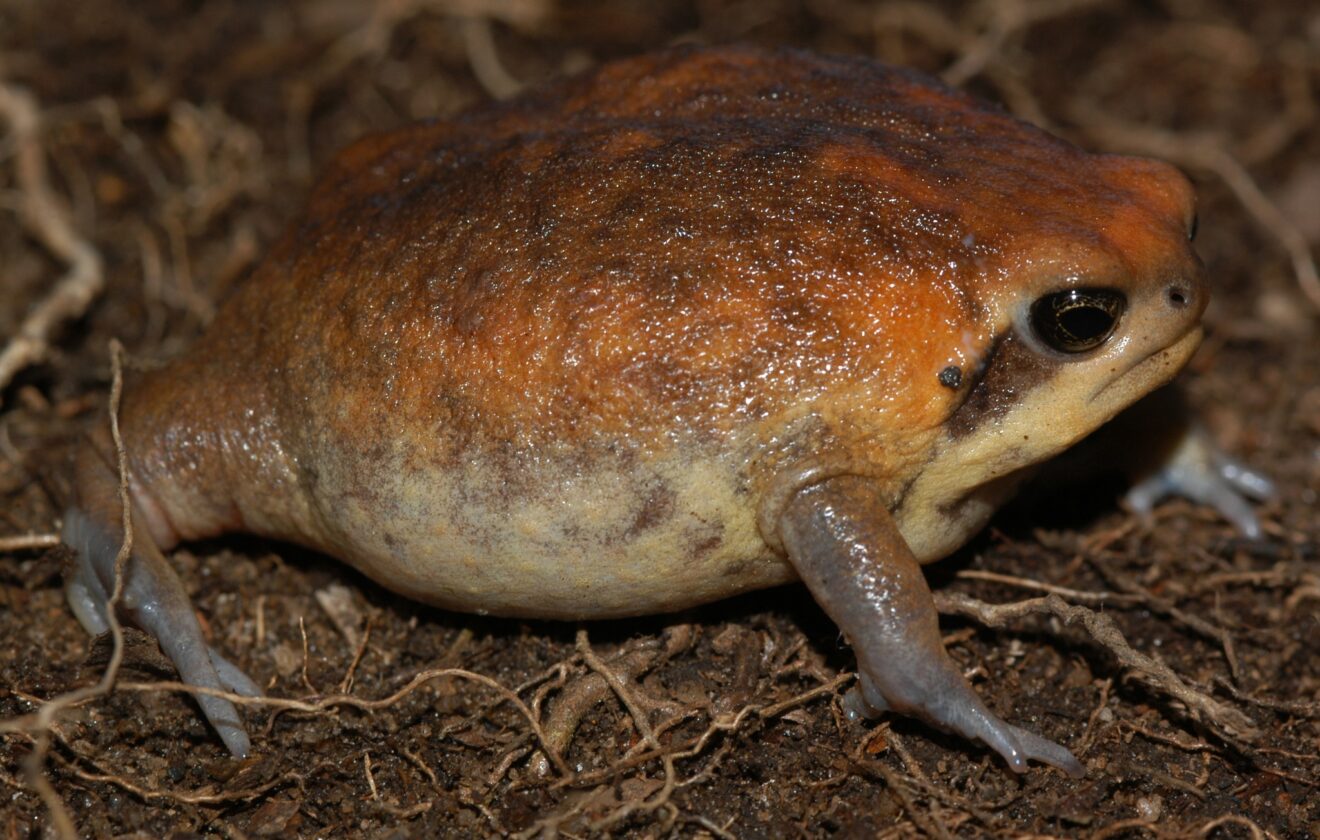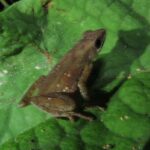Discovering Breviceps Sylvestris: The Enigmatic Forest Rain Frog#
Hidden beneath the lush green canopy and amid the humid leaf litter of Southern Africa’s ancient forests lurks an amphibious marvel—the forest rain frog, scientifically known as Breviceps sylvestris. Often elusive, always fascinating, this small terrestrial frog species has captivated herpetologists and nature enthusiasts alike with its unusual appearance, intriguing behaviors, and specialized ecological role. Plump and round, with expressive eyes and a face that seems perpetually comical, they are as delightful in their appearance as they are mysterious in their lifestyle. Join us as we journey deep into their secretive world to reveal the habits, trials, and triumphs inherent in the life of Breviceps sylvestris.
Taxonomy and Classification#
Breviceps sylvestris, commonly known as the forest rain frog, belongs to the family Brevicipitidae—a unique family of frogs found primarily in sub-Saharan Africa. Within this family, the genus Breviceps encompasses a group of uniquely adapted frogs exhibiting adaptations suited specifically to terrestrial life in moist, forested habitats rather than aquatic environments.
This remarkable genus boasts several species, each distinctive in their range and behavior. Breviceps sylvestris holds a special place among its relatives, not only due to its restricted distribution but also its ecological specificity. Related species like Breviceps macrops and Breviceps gibbosus share some traits and habitat preferences, yet B. sylvestris remains particularly associated with dense, moss-covered forest floors, distinguishing it ecologically and behaviorally from its cousins.
Natural Habitat#
Geographic Distribution#
The forest rain frog is endemic to South Africa, specifically restricted to the remnant indigenous forests and montane ecosystems located in KwaZulu-Natal and the Eastern Cape provinces. Its range primarily includes habitats such as the mist-belt forests of the Drakensberg escarpment, where perpetual moisture nourishes lush vegetation and carpets of moss and leaf litter provide shelter and food.
Habitat Preferences and Adaptations#
Unlike many frogs that live partly or wholly aquatic lives, B. sylvestris is adapted uniquely for terrestrial existence. To wander these forests is to fully grasp how vital this lush environment is to their survival. Beneath a dense canopy—etched in layers of ferns, mosses, and fallen leaves—the forest rain frog thrives. Each step through their habitat is like stepping back in time; the heavy, moist air wrapped in scents of decay and renewal creates the perfect microclimate for these frogs to flourish.
Breviceps sylvestris is known for burrowing into leaf litter and soft soil, spending much of their lives concealed. Their specialized limbs and uniquely round body shape give them exceptional digging capabilities. Moisture retention, so critical in their terrestrial life, is enhanced by the humid, shady environment of their forest home. Sudden rain showers trigger emergence behaviors, bringing this elusive creature briefly and spectacularly into view before blending harmoniously back into secrecy.
Physical Characteristics#
Aptly named “rain frogs” due to their habit of emerging after heavy rainfall, forest rain frogs are easily recognizable. With a body resembling a plump pebble or moist stone, their shape immediately draws attention. An adult typically measures between 20–30 millimeters, though despite this small size, their stocky form and disproportionately large heads impart an unmistakable appearance.
Skin texture provides another vital adaptation: rough, granulated skin not only aids camouflage amid damp leaf litter but also helps maintain moisture and offers protection from predators. Their coloration usually ranges from mottled browns, grays, and olive-green hues, closely matching the wet soil and mossy terrain they inhabit. Their eyes, large and expressive, appear oversized relative to their round forms, lending them an irresistibly endearing facial expression.
Perhaps the most peculiar physical adaptation is their shortened limbs, specifically designed for powerful digging. Instead of long, leap-oriented legs, B. sylvestris utilizes its robust hind limbs and feet to burrow underground rapidly. This specialized morphology ensures they spend most of their daylight hours beneath layers of protective substrate, emerging primarily at night or following rainfall.
Behavior and Life Cycle#
Feeding Habits and Diet#
Primarily nocturnal, these frogs awaken as darkness settles over their forest home. Diet consists predominantly of small invertebrates they find prowling through moist leaf litter: beetles, ants, termites, aphids, mites, and spiders form the bulk of their food sources. Equipped with sharp reflexes and a sticky, quick tongue, prey is quickly caught and consumed. Given their diminutive size, energy preservation and efficient feeding strategies are crucial for survival.
Reproduction: Secretive Courtships and Parental Care#
The reproductive behaviors of Breviceps sylvestris remain somewhat enigmatic, primarily due to their secretive nature. Breeding activities correspond closely with seasonal rainfall, as moisture availability directly impacts their reproductive viability. Males produce characteristic calls—soft, insect-like chirps—to attract mates, usually from hidden positions beneath leaves or within shallow burrows.
Unlike many amphibians, forest rain frogs bypass the aquatic tadpole stage, practicing direct development instead. Mated pairs excavate damp underground chambers where remarkably large eggs are deposited. Females exhibit attentive care, remaining in the burrow to guard and maintain egg moisture until fully developed froglets emerge. Direct development adaptations allow them to survive independently from birth, bypassing the risky aquatic larval stages typical in many other frog species—an amazing evolutionary strategy perfected through generations of forest dwelling.
Ecological Role#
As forest floor residents, Breviceps sylvestris play vital ecological roles within their microhabitat. Their appetite for small invertebrates significantly regulates pest populations, contributing indirectly to healthy forest vegetation. Likewise, these frogs themselves form an essential link in the food chain, supporting numerous predators like snakes, birds, and small forest mammals.
Additionally, their health and survival serve as indicators of ecosystem well-being. As amphibians, their permeable skin makes them especially sensitive to environmental disruptions, such as pollution or changes in humidity and temperature. Maintaining populations of B. sylvestris thus becomes a barometer of forest health, signaling broader ecological changes early and effectively.
Threats and Conservation Status#
Currently classified by the International Union for Conservation of Nature (IUCN) as Near Threatened, the future of Breviceps sylvestris faces numerous challenges. Habitat degradation and deforestation constitute predominant threats. Human encroachment, logging operations, and agricultural expansion increasingly fragment their delicate forest habitats.
Additionally, climate change raises serious long-term concerns. Altered rainfall patterns, increased drought incidences, and shifting regional temperatures threaten to disrupt their breeding cycles, essential moisture levels, and food availability entirely. Currently, conservation initiatives designed to preserve valuable indigenous forest habitats and promote sustainable land-use practices represent their best hope of protection.
Cultural and Scientific Significance#
Though not extensively featured in cultural narratives, forest rain frogs serve an important symbolic role for Southern Africa’s conservation movement—emblematic of the region’s unique biological heritage. From a scientific standpoint, they have contributed significantly to our understanding of evolution, direct terrestrial reproduction in frogs, and the adaptation mechanisms necessary to thrive in specialist forest niches.
Conclusion#
The humble yet fascinating existence of Breviceps sylvestris, hidden in South Africa’s misty forest floors, speaks volumes of ecological interconnectedness and adaptation resilience. Protecting this exceptional amphibian symbolizes protecting entire ecological webs and vital habitats. As nature lovers, conservationists, or curious observers, we bear witness to their extraordinary adaptations and behaviors, prompting us to champion their survival actively.
To help protect these wonderful creatures and their vibrant world, consider supporting local forest conservation initiatives or dedicated amphibian protection programs. Visit your local nature reserves, educate others, and advocate for sustainable practices—every small step ensures frogs like Breviceps sylvestris continue their timeless chorus within these magnificent forests.












